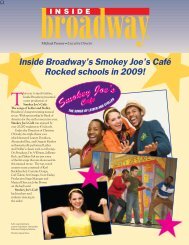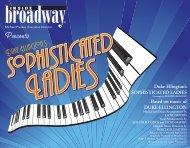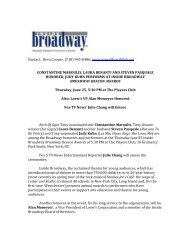You also want an ePaper? Increase the reach of your titles
YUMPU automatically turns print PDFs into web optimized ePapers that Google loves.
6<br />
I<br />
A<br />
B<br />
Y<br />
Y<br />
E<br />
U<br />
Z<br />
P<br />
L<br />
N<br />
Z<br />
O<br />
B<br />
F<br />
Rhythm, Blues and Clues<br />
V<br />
Q<br />
L<br />
C<br />
A<br />
S<br />
S<br />
E<br />
T<br />
T<br />
E<br />
O<br />
F<br />
P<br />
Y<br />
J<br />
X<br />
U<br />
L<br />
K<br />
W<br />
I<br />
G<br />
V<br />
G<br />
C<br />
B<br />
D<br />
I<br />
K<br />
X<br />
R<br />
E<br />
C<br />
O<br />
R<br />
D<br />
V<br />
N<br />
H<br />
S<br />
P<br />
A<br />
D<br />
R<br />
ALBUM<br />
CASSETTE<br />
GUITAR<br />
RADIO<br />
ROCK<br />
F<br />
O<br />
S<br />
N<br />
A<br />
R<br />
H<br />
A<br />
L<br />
B<br />
U<br />
M<br />
X<br />
R<br />
Q<br />
Y<br />
C<br />
B<br />
T<br />
Z<br />
T<br />
S<br />
Y<br />
O<br />
E<br />
W<br />
R<br />
E<br />
V<br />
R<br />
R<br />
K<br />
Y<br />
K<br />
T<br />
H<br />
O<br />
V<br />
T<br />
R<br />
Q<br />
O<br />
J<br />
X<br />
E<br />
D<br />
F<br />
X<br />
F<br />
V<br />
K<br />
N<br />
F<br />
S<br />
H<br />
B<br />
Y<br />
X<br />
T<br />
Q<br />
BLUES<br />
DION<br />
IPOD<br />
RECORD<br />
ROLL<br />
L<br />
V<br />
X<br />
L<br />
E<br />
J<br />
W<br />
F<br />
C<br />
O<br />
M<br />
F<br />
L<br />
C<br />
F<br />
Y<br />
K<br />
F<br />
V<br />
I<br />
P<br />
G<br />
F<br />
G<br />
J<br />
D<br />
D<br />
B<br />
B<br />
V<br />
W<br />
K<br />
S<br />
V<br />
O<br />
U<br />
I<br />
U<br />
X<br />
H<br />
W<br />
G<br />
M<br />
Y<br />
L<br />
D<br />
P<br />
F<br />
E<br />
D<br />
P<br />
I<br />
E<br />
U<br />
D<br />
S<br />
S<br />
O<br />
W<br />
T<br />
U<br />
D<br />
G<br />
A<br />
O<br />
T<br />
U<br />
N<br />
Q<br />
N<br />
G<br />
R<br />
W<br />
P<br />
L<br />
N<br />
O<br />
I<br />
D<br />
A<br />
R<br />
G<br />
G<br />
E<br />
L<br />
Y<br />
W<br />
Z<br />
K<br />
S<br />
BROADWAY<br />
ELVIS<br />
PHONOGRAPH<br />
RHYTHM<br />
Music<br />
1 2<br />
& More3 4 5<br />
Across:<br />
1. collection of 12 or more<br />
recorded songs<br />
4. Ruby Baby singer<br />
6. used for tape recorders<br />
8. original Hound Dog singer<br />
9. 35th President of the United States<br />
10. first multiple record player<br />
11. composer<br />
12. Jailhouse Rock singer<br />
8<br />
12<br />
10<br />
11<br />
7<br />
9<br />
H<br />
P<br />
A<br />
R<br />
G<br />
O<br />
N<br />
O<br />
H<br />
P<br />
M<br />
K<br />
K<br />
P<br />
G<br />
Searchin<br />
Down:<br />
2. lyricist<br />
3. made first appearance<br />
on Ed Sullivan in 1964<br />
5. invented the phonograph<br />
7. country and rock hybrid<br />
Help the musical note find it’s home<br />
Where the<br />
Music Lives<br />
OF ROL ROC ND<br />
ALL<br />
K A<br />
Unscramble<br />
the tiles<br />
to reveal a<br />
message.<br />
Where Leiber and Stoller Ended Up…<br />
A B C D E F G H I J K L M N O P Q R S T U V W X Y Z<br />
10 19 25 2 22 4 9 3 44 26 17 18 7 23 21 29 30 20 24 8 6 11 1 28 14 31<br />
K ‘ A A A<br />
L H<br />
24 7 21 17 22 14 26 21 22 24 25 10 4 22 21 23 19 20 21 10 2 1 10 14<br />
ME<br />
FA<br />
Michael Presser, Executive Director<br />
Presents…<br />
Michael Presser, Executive Director<br />
Board of Directors<br />
Irwin Fingerit, Chairman<br />
Michael Presser, President<br />
Howard Zipser, Vice President<br />
Elliot Altman. Treasurer<br />
William Tung, Secretary<br />
Richard Basini<br />
David I. Cohen<br />
Joseph V. Cozza<br />
John Diaz<br />
Anthony W. Guido<br />
Eric Gural<br />
Mark Irgang<br />
Mary Landolfi<br />
Alan Momeyer<br />
George Stonbely<br />
Honorary Members<br />
Barbara J. Fife<br />
Mrs. Bernard B. Jacobs<br />
James L. Nederlander<br />
Vicki Singer<br />
Advisory Board<br />
Carol Channing –<br />
Honorary Chair<br />
Roger Bart<br />
Mary Ellin Barrett<br />
Laura Benanti<br />
Stephen W. Bogardus<br />
Danny Burstein<br />
Theodore S. Chapin<br />
Kristin Chenoweth<br />
Barbara Cook<br />
Alan Eisenberg<br />
Tovah Feldshuh<br />
Sutton Foster<br />
Joel Grey<br />
Jasmine Guy<br />
Nathan Lane<br />
Paul Libin<br />
Pia Lindstrom<br />
Rebecca Luker<br />
Peter L. Malkin<br />
Karen Mason<br />
Donna Murphy<br />
Bebe Neuwirth<br />
Fred Papert<br />
Faith Prince<br />
Gerald Schoenfeld<br />
Susan L. Schulman<br />
Susan Stroman<br />
Karen Ziemba<br />
Study Buddy<br />
630 Ninth Avenue, Suite 802<br />
New York, NY 10036<br />
Telephone: 212-245-0710<br />
Fax: 212-245-3018<br />
www.insidebroadway.org<br />
Teaching Artists<br />
Clark Ausloos<br />
Jen Faith Brown<br />
Nathan Christensen<br />
Michael Flanagan<br />
BJ Gandolfo<br />
Dan Gordon<br />
Samantha Hancock<br />
Adam Hose<br />
Angela Jamieson<br />
Abigail Jones<br />
Mark Lingenfelter<br />
Braddon Mehrten<br />
Evan Paquette<br />
Kerry Prep<br />
Shay Saint-Victor<br />
Ethan Wagner<br />
Britton Williams<br />
Lindsay Wood<br />
Administrative Staff<br />
Michael Presser,<br />
Executive Director<br />
Nicholas M. Sala,<br />
Company Manager<br />
Katie McAllister,<br />
Program Director<br />
Abigail Jones,<br />
Comptroller<br />
Laura Jean Hawkins,<br />
Government Relations<br />
The Dryfoos Group<br />
David Jaffe,<br />
Marketing & Events<br />
Jaffe Management, Inc<br />
Melissa Fisher,<br />
Development Consultant<br />
Reva Cooper,<br />
Publicity<br />
Jeremy Howowitz,<br />
Web Design<br />
Our Mission:<br />
<strong>Inside</strong> <strong>Broadway</strong> is a professional New York City based children’s theatre<br />
company committed to producing <strong>Broadway</strong>’s classic musicals in a<br />
contemporary light for young audiences.<br />
Our Supporters:<br />
The New York City Department of Education; New York State Office of<br />
Children and Family Services; New York City Department of Cultural<br />
Affairs; New York City Department of Youth and Community<br />
Development; New York State Office of Parks, Recreation and Historic<br />
Preservation and New York State Department of Education.<br />
New York City Council; Christine Quinn, Speaker, Domenic Recchia,<br />
Chair Cultural Affairs Committee and Council Members Joseph<br />
Addabbo, Jr., Tony Avella, Anthony Como, Erik Martin Dilan, Lew Fidler,<br />
Dan Garodnick, Eric Gioia, Vincent Gentile, Sara Gonzalez, Melinda Katz,<br />
Michael McMahon, Annabel Palma, Joel Rivera, Larry Seabrook, Helen<br />
Sears, James Vacca and Thomas White, Jr.<br />
New York State Assembly Members Peter Abbate, Michael Benedetto,<br />
Jonathan Bing, Barbara M Clark, Vivian E Cook, Adriano Espaillat,<br />
Michael Gianaris, Richard Gottfried, Rhoda Jacobs, Brian Kavanagh,<br />
Micah Kellner, Felix Ortiz, Mike Spano, Michele Titus, Mark Weprin and<br />
Ellen Young<br />
New York State Senators Andrew Lanza, John Flanagan, George Onorato<br />
and Tom Duane<br />
These programs are supported in part, by public funds<br />
from the New York City Department of Cultural Affairs.<br />
<strong>Inside</strong> <strong>Broadway</strong> also receives support from The Shubert Foundation;<br />
American Friends of Theatre; Theatrical Stage Employees, Local One<br />
IATSE; Associated Musicians of Greater New York; Local 802, AFM; Fund<br />
for the City of New York; Bank of America; Loews Corporation; Clear<br />
Channel Spectacolor; Newmark & Company Real Estate; Con Edison;<br />
The Rockefeller Group Development Corporation; The Malkin Fund;<br />
New York Community Trust; RHI Entertainment; Max and Victoria Dreyfus<br />
Foundation, Inc., Spectacular Ventures, Cushman & Wakefield, Cipriani<br />
USA, High Rise Systems, Inc., Stadtmauer Bailkin LLP, The Shubert<br />
Organization, Inc., The Times Square Alliance, The Town Hall Foundation,<br />
The Vesper Foundation and The Joelson Foundation.<br />
<strong>Inside</strong> <strong>Broadway</strong> is a member of The <strong>Broadway</strong> League, Producers League<br />
of Theatre for Young Audiences, Inc. (PLOTYA); Alliance of Residence<br />
Theatres/New York (A.R.T./ New York); New York City Arts in Education<br />
Roundtable (AIE), NYC Arts Coalition, The Mayor’s Midtown Citizens<br />
Committee and The <strong>Broadway</strong> Association.<br />
Bank of America is a proud sponsor of <strong>Inside</strong><br />
<strong>Broadway</strong>’s 2008-2009 school tour of <strong>Smokey</strong> Joe’s Café<br />
© <strong>Inside</strong> <strong>Broadway</strong> 2009. All Rights Reserved.<br />
Study Buddy written by Katie McAllister Design by Cybill Conklin
Leiber and Stoller<br />
Biography<br />
Jerry Leiber and Mike Stoller met in Los Angeles,<br />
California in 1950 and began writing music together<br />
right away. Leiber served as lyricist while Stoller, a classically<br />
trained but jazz and R&B loving composer wrote the music. In 1952<br />
the pair was invited by Johnny Otis to write songs for Big Mama Thornton,<br />
an R&B singer from Montgomery Alabama. Their first song for her? “Hound<br />
Dog” which was an immediate hit and #1on the Billboard R&B charts for seven<br />
consecutive weeks. Three years later this song would be re-recorded by Elvis<br />
Presley and become an instant classic. Leiber and Stoller went on to write<br />
additional songs for Elvis including “Jailhouse Rock” and “Treat Me Right”.<br />
Together Leiber and Stoller wrote some of the most popular songs of all time,<br />
including “Stand By Me”, “Love Potion #9”, “Charlie Brown”, “Poison Ivy”,<br />
“Spanish Harlem” and “On <strong>Broadway</strong>”. They have received a star on the<br />
Hollywood Walk of Fame and in 1987, were inducted into the Rock and Roll Hall<br />
of Fame. The song writing duo is still active in the music industry today, in fact<br />
their music was recently used on American Idol.<br />
On<br />
<strong>Broadway</strong><br />
How did a composer from Long Island, and a lyricist from<br />
Baltimore end up on <strong>Broadway</strong>? Well, in 1995 <strong>Smokey</strong><br />
Joe’s Café, a musical revue of the songs of Leiber and<br />
Stoller began its run at the Virginia Theatre on <strong>Broadway</strong>.<br />
The show was directed by Jerry Zaks with choreography<br />
by Joey McKneely and featured 40 of Leiber and Stoller’s<br />
greatest hits. The production played for 2,036 performances<br />
and was nominated for 5 Tony Awards, including<br />
best musical. Professional productions are still playing in<br />
theatres around the world, most recently in China.<br />
Baby That’s Rock and Roll<br />
How did Rock and Roll get started? Where did it come from? Who is<br />
responsible? The roots of Rock and Roll are in several musical forms including<br />
Jazz , Gospel and R&B, but to really understand how it came to be, we<br />
have to go back to 1951 and to what is regarded as the first rock’n’roll<br />
single. “Rocket 88” was written by Ike Turner and sung by Jackie Brenston.<br />
This song is widely regarded by many to be the first rock and roll song, but<br />
others contend that 1954’s “Rock Around the Clock” by Bill Haley and the<br />
Comets was the first. Still others think that the first was 1948’s “Rock and<br />
Roll” by Detroit boxer Wild Bill Moore. Since there are so many different<br />
opinions on this subject, which one do we believe?<br />
Well, like any art form, Rock and Roll was constantly<br />
evolving, so our perception of what made a song “rock”<br />
changed with each new incarnation. All of these songs<br />
share some of the characteristics of the genre like guitar<br />
licks, drum snare accents and a “rockabilly” feel.<br />
When Rock and Roll was at it’s golden age in the 1950’s, it was<br />
welcomed by teenagers, but not so much by adults who didn’t understand<br />
why their children wanted to listen to music that was “loud and obnoxious”<br />
instead of the swing and big band music that they grew up with. Sound<br />
familiar?<br />
Cover Me<br />
Since album art was first introduced<br />
in 1939, it has evolved in both it’s<br />
format and subject matter. Initially,<br />
album covers were drawn illustrations<br />
influenced by European poster art.<br />
Alex Steinweiss is credited with<br />
creating the art form and was<br />
known for signing his creations. He argued<br />
that the art on the cover of the album would make the<br />
customer stop and look at the record and in all likelihood, buy it.<br />
In the early 1950’s technological advancements in photography allowed<br />
for illustrated covers to be replaced with “head shots” of the recording<br />
artist or photographs of a landscape or landmark.<br />
Today, cover art is a mixture of both illustration and photography and<br />
often reflects the theme of the album or the artist’s personal taste.<br />
Rock and Roll Hall of Fame<br />
The Rock and Roll Hall of Fame and Museum is dedicated to the preservation<br />
of the history of some of the best known and most influential artists and<br />
music producers who have made major contributions to the music industry.<br />
The museum was founded in 1986 and is located in Cleveland, Ohio. The<br />
museum inducts a handful of artists into the Hall of Fame each year. To be<br />
eligible for induction, a group or individual must have released their first<br />
record at least 25 years ago. There are four categories: Performers, Non-<br />
Performers, Early Influences, and Sidemen. Each year, about five to seven<br />
people (or groups) are inducted into the hall of fame, this is done through a<br />
nomination process and then voted on by 1000 experts in the music industry.<br />
Past inductees have included Elvis Presley, Chuck Berry, Little Richard,<br />
James Brown, Bob Marley, The Rolling Stones, Aerosmith, U2, The Platters,<br />
The Drifters, The Beatles, The Beach Boys, Elton John, Michael Jackson,<br />
Madonna, Ray Charles, The Four Seasons and Buddy Holly.<br />
Listen to the Music<br />
Today when we want to listen to our favorite songs we pull out our ipod<br />
and go. It wasn’t always so easy to listen to music, in fact just over a hundred<br />
years ago you would have had to go to a concert to hear it.<br />
People have been listening to music for hundreds, even thousands of<br />
years. The only thing that has changed is how we listen to it.<br />
The first widely used mechanism for playing music was the phonograph,<br />
invented in 1877 by Thomas Edison. Unlike modern record players, the<br />
phonograph was a wind-up turn table that emitted sound from a large<br />
horn attached to the player. Next came the radio which started as a<br />
means of communicating between ships and in the 1920’s became the<br />
radio that we listen to today in our cars and homes. In the beginning,<br />
radios played nightly programs that consisted of live concerts and radio<br />
“theatre” shows.<br />
The next big step came in 1927 with the creation of the first electrically<br />
amplified multi-selection phonograph or as it is more commonly known<br />
the “Jukebox”. The term “Jukebox” comes from the word “Jook” which<br />
is an old African American slang term meaning to dance, it also comes<br />
from Southern “Jute Joints” or dance halls of the 1920’s where Jukeboxes<br />
would appear. This invention revolutionized dance halls as it could play a<br />
multitude of songs at the fraction of the cost of a live band. In its heyday,<br />
the Jukebox showcased artists enabling them to sell hundreds of records<br />
at once for artists like Chuck Berry and Jerry Lee Lewis.<br />
In 1964 Phillips introduced the compact cassette tape player which was<br />
originally used for voice dictation due to its poor sound quality. The eight<br />
track tape followed as an answer to a compact music system with better<br />
sound. In the 1980’s the portable cassette player gained popularity with<br />
the Sony Walkman and cassette tape sales skyrocketed. With the onset of<br />
digital recording onto CD’s in early 90’s, Sony’s CD Walkman had overtaken<br />
the cassette player as the portable music player of choice.<br />
This brings us to the invention of the ipod by Apple. While CD players are<br />
still popular, the ipod, and mp3 player brought the art of listening to<br />
music into a whole other age. With its capacity to store over 2,000 songs<br />
and play movies among other things, the ipod has revolutionized not only<br />
how we listen to music, but how we purchase it. In recent years the<br />
recording industry has seen a decline in traditional album sales as people<br />
purchase their music from online sources.<br />
With technology improving everyday, and ipods, mp3 players and even<br />
phones changing, who knows how we will listen to music in the future.<br />
For the<br />
Record<br />
Want to buy the latest hit record? Pretty<br />
easy, right? Just go to itunes or Rhapsody<br />
and download it onto your ipod or computer.<br />
Well, before technology made it so easy for<br />
us to get our music from the internet, people<br />
bought records in stores. Not CDs or tapes or<br />
even eight tracks. There were records, period.<br />
There were two kinds of records – Albums,<br />
which had 12 songs (6 on each side) and<br />
45’s which had only 2 songs<br />
(1 on each side). 45’s were<br />
very popular in the 50’s and<br />
60’s as they usually cost<br />
about a dollar and could be<br />
afforded by most teenagers.<br />
A 45 typically had the “hit”<br />
song on one side and the<br />
“flip” or “B” side contained a<br />
lesser known number by the<br />
same artist.<br />
1935-1977 Elvis Aron Presley was born in Tupelo,<br />
Mississippi on January 8, 1935. Elvis grew up surrounded<br />
by gospel, blues and jazz and incorporated<br />
those musical styles into his own brand of rock<br />
and roll. In 1957, he recorded the Leiber and<br />
Stoller song “Houng Dog” which was an immediate<br />
success for both the singer and the songwriters.<br />
Elvis continued his collaboration with<br />
them on the song “Jailhouse Rock” and covered<br />
over a dozen of their songs throughout<br />
his recording career. Elvis served in the military<br />
during the Korean War thus inspiring<br />
the title character in the musical “Bye Bye<br />
Birdie”. He made 33 films, recorded 131<br />
albums and received the Lifetime<br />
Achievement Grammy at the age of 36.<br />
Elvis’ influence on American pop culture<br />
and music is still felt today.<br />
Notable Notables<br />
The fifties and sixties were a time of change, not only in music, but in the<br />
world. Below are some of the people who made great contributions to our<br />
society.<br />
Rosa Parks (1913-2005) is most famous for<br />
her refusal to give up her seat for a white man<br />
on a bus, which sparked the Montgomery,<br />
Alabama bus boycott. Ms. Parks continued<br />
to be a force in the fight for Civil Rights<br />
throughout her life, eventually establishing<br />
the Rosa and Raymond Parks Institute for<br />
Self Development. Miss Parks was voted<br />
by Time Magazine as one of the 100 Most<br />
Influential People of the 20th Century<br />
and received both the Congressional Gold<br />
Medal of Honor and the Presidential Medal of Freedom.<br />
Rosa Parks died on October 24, 2005, she was 92 years old.<br />
Martin Luther King (1929- 1968) is one of the most beloved and influential<br />
figures in American history. A noted civil rights activist who participated in<br />
the Montgomery, Alabama bus boycott, he also fought against segregation<br />
in schools and was know for his “non-violent” approach to protest marches.<br />
At the age of 35, he was the youngest recipient of the Nobel Peace Prize.<br />
MLK was known for his persuasive and elegant speeches, his most famous is<br />
his “I Have a Dream” speech which was delivered on the steps of the<br />
Lincoln Memorial. Dr. King was assassinated on the balcony of his hotel<br />
room on April 4, 1968.<br />
John F Kennedy (1917- 1963) - the 35th President of the United States of<br />
America, JFK was the youngest man ever elected to the office of President.<br />
He was an advocate of the Arts and often attended <strong>Broadway</strong> productions<br />
with Camelot, being his favorite show. President Kennedy also believed in<br />
the youth of America and was an avid supporter of groups like the Peace<br />
Corp and the Alliance for Progress. He is remembered for his inaugural<br />
speech and for the phrase “Ask not what your country can do for you, ask<br />
what you can do for your country”. President Kennedy was assassinated on<br />
November 22, 1963 in Dallas Texas.<br />
The Music<br />
Makers<br />
While Leiber and Stoller wrote<br />
the music, there were many<br />
different individuals and groups<br />
who recorded their songs.<br />
Big Momma Thornton<br />
(1926-1984) was born<br />
Willie Mae Thornton in<br />
Montgomery, Alabama.<br />
She was known for her<br />
“booming” voice and was<br />
a fixture on the rhythm<br />
and blues circuit. In 1953,<br />
Leiber and Stoller wrote<br />
the song “Hound Dog” for<br />
her which reached number<br />
1 on the R&B charts.<br />
The Clovers were<br />
considered to be the first<br />
rhythm and blues groups<br />
to cross over into rock<br />
and roll. They combined<br />
gospel and blues for a<br />
unique sound. The group<br />
was signed by Atlantic<br />
Records in 1951 and soon<br />
after recorded their hit<br />
“Love Potion #9”.<br />
The Drifters recorded the<br />
Leiber and Stoller song<br />
“There Goes My Baby” in<br />
1959. The song was co-written<br />
by then lead singer Ben E.<br />
King, who went onto record<br />
Leiber and Stoller’s “Stand<br />
By Me” and “Spanish<br />
Harlem” as a solo artist. The<br />
Drifters were inducted into<br />
the Rock and Roll Hall of<br />
Fame in 1988.<br />
The Coasters (1956 to 1961) The<br />
Coasters released a string of hits<br />
written by Leiber and Stoller, including<br />
“Searchin’” “Young Blood”, “Charlie<br />
Brown”, “Yakety Yak” and their<br />
most famous recording, “Poison Ivy”.<br />
Originally named the “Robins” the<br />
group changed their name when they<br />
signed with Leiber and Stoller’s label,<br />
“Spark Records”. The Coasters were<br />
inducted into the Rock and Roll Hall<br />
of Fame in 1987.<br />
Dion Whose real name was Dion<br />
DiMucci, grew up in Bronx NY and<br />
formed the singing group “Dion and<br />
the Belmonts” which was so named<br />
for Belmont Avenue. Dion was a<br />
teen idol from 1958 to 1963 recording<br />
such hits as “I Wonder Why”,<br />
“Teenager in Love”, “Runaround Sue”<br />
and the Leiber and Stoller hit “Ruby<br />
Baby”. Dion and the Belmonts were<br />
inducted into the Rock and Roll Hall<br />
of Fame in 1989.








